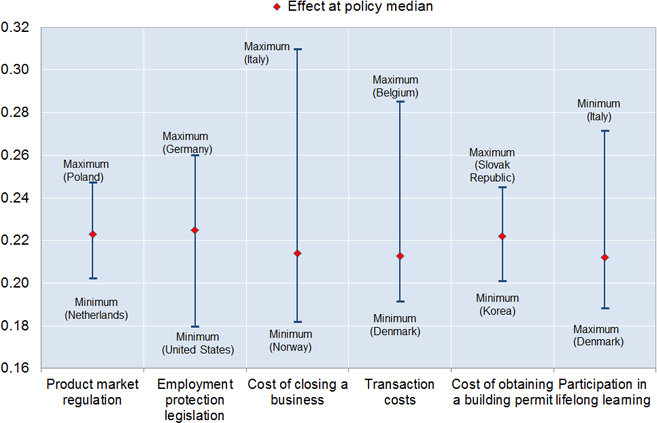Productivity growth is the main driver of living standards. But productivity has slowed over the 2000s, even before the crisis, partly owing to a slowdown in diffusion of global frontier innovations to other firms. This column argues that policy reforms can help revive the diffusion machine, optimise the use of scarce resources—especially skills—and clear the path for higher productivity growth more generally.
The productivity slowdown over the past decade has raised concerns about the long term growth outlook. Yet, the future of productivity is highly uncertain with contrasting views on the potential for innovation to further propel growth (Gordon, 2012; Brynjolfsson and McAfee, 2011). In this context, a new Organisation for Economic Cooperation and Development (OECD) study argues that countries should look to tap two key sources of productivity growth where there is potentially large and sure scope for improvement: knowledge diffusion and resource allocation.
There is much scope for policy to raise growth via these channels and in a potentially inclusive fashion. Since the rise in wage inequality largely reflects the increasing dispersion in wages paid across firms (Card et al., 2013; Song et al., 2015), raising the productivity of laggard firms—via more effective diffusion—could contain increases in wage inequality. A better matching of skills to jobs also makes workers more productive—implying higher wages—and reduces the risk that under-utilised skills will quickly depreciate.
The breakdown of the diffusion machine
Our research shows that a key feature of the productivity slowdown is not so much a slowing of innovation by the most globally-advanced firms, but rather a slowing of the pace at which innovations spread out throughout the economy—a breakdown of the diffusion machine. Labour and total factor productivity growth of the globally most productive firms remained robust in the 21st century, despite the slowdown in aggregate productivity, but the gap between those high productivity firms and the rest has been increasing over time. Labour productivity at the global technological frontier increased at an average annual rate of 3.5% in the manufacturing sector over 2000s, compared to just 0.5% for non-frontier firms, while the gap is even more pronounced in the services sector (Figure 1). Concurrent analysis using a cross-country industry-level dataset beginning in the mid-1980s also suggests that the diffusion machine broke down in the early 2000s.
but spillovers to the other firms have been weak
Labour productivity; index 2001=0
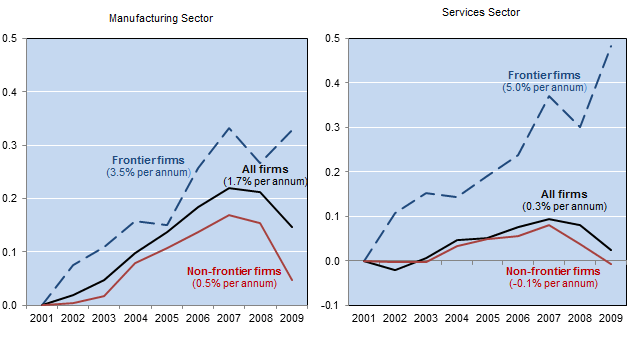
The relative strength of such global frontier firms likely reflects their capacity to both "innovate" and to optimally combine intangible inputs in production processes throughout global value chains (GVCs) and harness the power of digitalisation to rapidly diffuse and replicate leading-edge ideas. More significantly, the rising gap between those high productivity firms and the rest raises key questions about the obstacles that prevent all firms from adopting seemingly well-known and replicable innovations.
The process of technological diffusion is highly uneven, and global frontier technologies only potentially diffuse to laggards once they are adapted to country-specific circumstances by the most productive firms within each country (i.e., national frontier firms). This diffusion process is shaped by some key factors:
- Global connections via trade, foreign direct investment (FDI), participation in GVCs and the global mobility of skilled labour provide scope for diffusion from global frontier firms to national frontier firms. Globalisation also implies stronger competition which sharpens the incentives to adopt best practices.
- Experimentation by firms—especially new entrants—with new technologies and business models.
- Synergic investments in research and development (R&D), skills and organisational know-how (i.e., managerial quality) to enable economies to absorb, adapt and reap the full benefits of new technologies.
- Efficient resource allocation to underpin the growth of innovative firms. This is particularly vital given that firms need to achieve sufficient scale to cover the fixed costs of entry into global markets and to incentivise experimentation, by making it easier to scale-up successful ideas.
OECD countries differ significantly with respect to these factors—implying that diffusion comes easier to firms in some economies than others. Given a 2% acceleration in productivity growth at the global frontier—roughly equivalent to that observed in the United States during the late 1990s information and communications technology (ICT) boom—an economy that allocates skilled labour efficiently (e.g., Belgium) would realise 0.25 percentage points higher productivity growth per annum from more rapid diffusion, compared to a country where the allocation of skills is inefficient (e.g., Italy). These gains from improved diffusion are economically significant, given an average multifactor productivity (MFP) growth of only 1/2 per cent per annum over the period 1995 to 2007.
Estimated frontier spillovers (% per annum) associated with 2% point increase in MFP growth at the global frontier
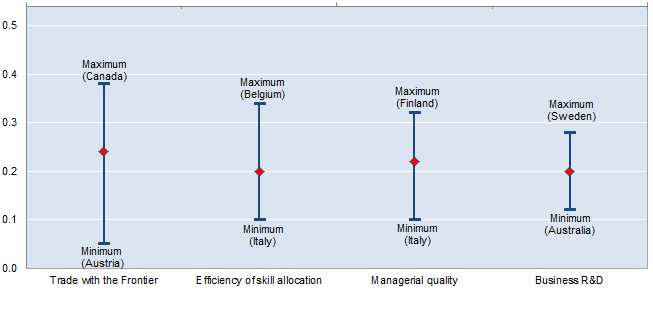
Misallocation, big time
Besides supporting diffusion, efficient resource allocation has important direct effects on productivity growth. The larger are the more productive firms, the greater the extent to which their good performance gets reflected in overall economic growth. Unfortunately, the most productive firms do not always grow to optimal scale. In some economies (e.g., Italy), the most advanced firms have productivity levels close to the global frontier, but they are undersized relative to their peers in other countries (Figure 3). These findings are consistent with recent research for the broader economy which shows that: i) the share of small firms is much higher in Italy, than in the United States and other OECD countries (Criscuolo et al., 2014); and ii) the United States is much more successful than Italy at channelling scarce resources to the most productive firms (Andrews and Cingano, 2014) and to innovative firms (Andrews et al., 2014).
How much would overall manufacturing sector productivity rise if firms at the national frontier were as productive and large as firms at the global frontier?
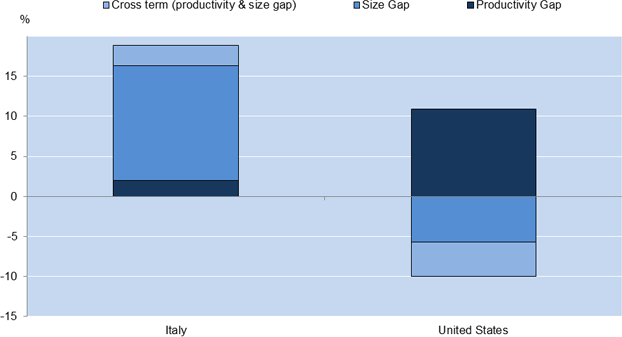
There is considerable scope to improve the allocation of talent, with roughly one-quarter of workers reporting a mismatch between their existing skills and those required for their job (Figure 4). Higher skill mismatch is associated with lower labour productivity performance, with over-skilling—which is more common than under-skilling—being particularly costly. When firms draw from a scarce and fixed pool of skilled labour, trapping highly-skilled labour in relatively low productivity firms can make it more difficult for more productive firms to attract the workers necessary for their expansion. This is what tends to occur in industries with a high share of over-skilled workers. A better use of human talent in countries where skill mismatch is very high, such as Italy and Spain, could boost the level of labour productivity by around 10%. This could close about one-fifth of the gap in labour productivity between Italy and the United States.
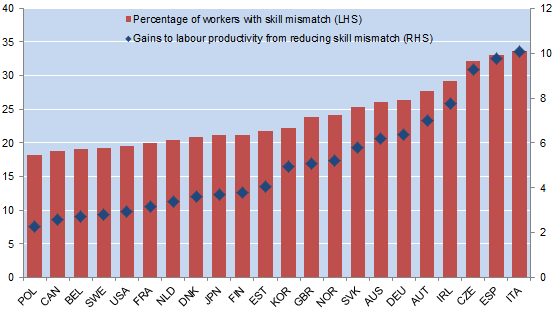
High rates of skill mismatch often coincide with the presence of many ageing firms that are relatively small. These firms are often unproductive and absorb valuable resources, thereby constraining the growth of more innovative firms. While young firms are generally characterised by an up or out dynamics, whereby many firms exit but those that success can growth very rapidly, there are significant differences across countries in the extent to which this process can take place resulting in very different firm age and size profiles. For instance, only 22% of small firms in Finland—which account for 41% of total employment—can be classified as "young" (i.e., less than 5 years old), against more than 50% in the United States (Figure 5). This likely reflects the inability to grow to scale and the fact that unsuccessful firms can survive when market selection is weak: for example, while old businesses in the United States are more than seven times larger than start-ups, this ratio drops to two or less in Italy, France and Finland.
A: Many small and old firms suggest less intense market selection in some countries
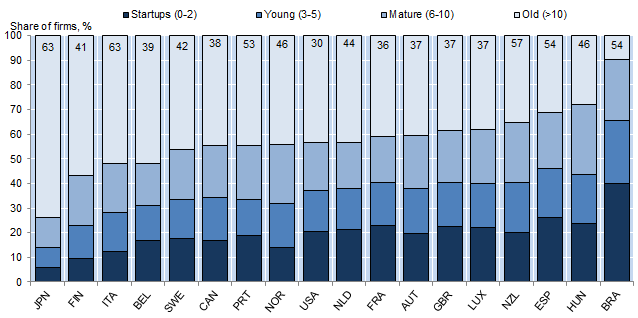
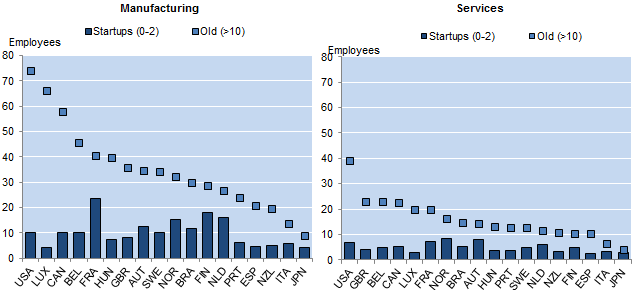
Policies to revive productivity growth
Although productivity growth at the global frontier appears robust, a policy framework that incentivizes frontier innovations is crucial. In fact, the overall decline in the rate of business start-ups and the rising age of global frontier firms—which could foreshadow a slowdown in the arrival of radical innovations and future productivity growth—make policies for innovation an indispensable ingredient (conditio sine qua non) for long term growth.
- Higher and more efficient public funding of basic research are crucial for moving the global frontier outward. Given the tight fiscal climate, this is going to be easier if countries share the costs and risks of such research through stronger collaboration.
- Pushing out the frontier also requires enabling experimentation with radical new technologies and business models. Since innovation is about trial and error, failure needs to be recognised as an opportunity to learn and rebound, rather than being seen as the end of the game. Thus the policy environment should enable successful firms to grow, but also let less successful firms exit the market, so that scarce resources can be released to underpin the growth of the successful ones.
Securing future growth prospects depends on re-harnessing the forces of knowledge diffusion. This requires a policy framework that supports basic research and experimentation but also one that fosters:
- Pro-competition reforms to product markets, especially in services, incentivising firms to adopt better technologies and improve managerial performance. Given a 2% acceleration in frontier growth, MFP growth would be 0.2 percentage points when administrative barriers to entrepreneurship are low (e.g., Sweden), compared to when such barriers are high (e.g., Greece), due to more effective diffusion (Figure 6). Such reforms will also help reduce the costs and improve the quality of goods and services, which will boost the benefits of participation in GVCs.
- Closer collaboration between firms and universities to allow firms, especially smaller ones, to benefit from university connections with the global knowledge frontier and to provide them with access to research labs, machinery and knowledge that they would not be able to afford otherwise.
- A level playing field that does not favour incumbents over entrants. Unlike incumbent firms, many young innovative firms typically make losses in the early years of an R&D project and thus will not benefit from R&D tax incentives unless they provide for immediate cash refunds for R&D expenditure or allow associated losses to be carried forward to deduct against future tax burdens.
Estimated frontier spillover (% per annum) associated with 2% point increase in MFP growth at the global frontier
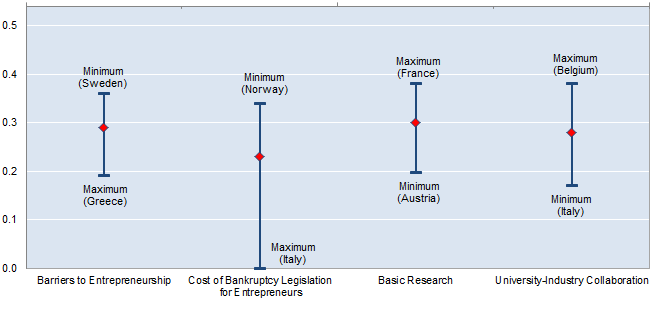
The aggregate benefits of diffusion will be magnified when scarce resources are easily reallocated to underpin the growth of the productive firms, and structural reforms can contribute greatly to this process (Andrews and Cingano, 2014; Andrews, et al., 2014). Product markets reforms—via stronger competitive pressure—can contribute to a more efficient allocation of resources, especially skills (Figure 7). Besides well-functioning financial markets and an adequate supply of risk capital, three key channels emerge through which policies can improve resource allocation.
First, policies that promote efficient firm exit—such as bankruptcy legislation that does not excessively penalise business failure—can reduce the likelihood that valuable resources are trapped in inefficient firms. For example, reducing the stringency of bankruptcy legislation from its most restrictive level in Italy to the median level in Canada is associated with a 10 percentage point decrease in mismatch (Figure 7). This in turn facilitates more effective knowledge diffusion (Figure 6).
Second, policies that make labour mobility smoother can underpin the growth of productive firms. Employment protection legislation that does not impose heavy or unpredictable costs on hiring and firing can: i) improve resource allocation, especially with respect to skills; and ii) make it more attractive for firms to experiment with uncertain technologies, by lowering exit costs. Similarly, lower transaction costs affecting the buying and selling of dwellings—e.g., stamp duties and notarial fees—can reduce skill mismatch by enhancing higher residential mobility. The same is true for policies that do not restrict housing supply, such as less stringent land-use regulations.
Finally, adult learning policies that make skills complementary to technical progress can support inclusive growth by better matching skills competencies to jobs.
The probability of skill mismatch and selected policies
